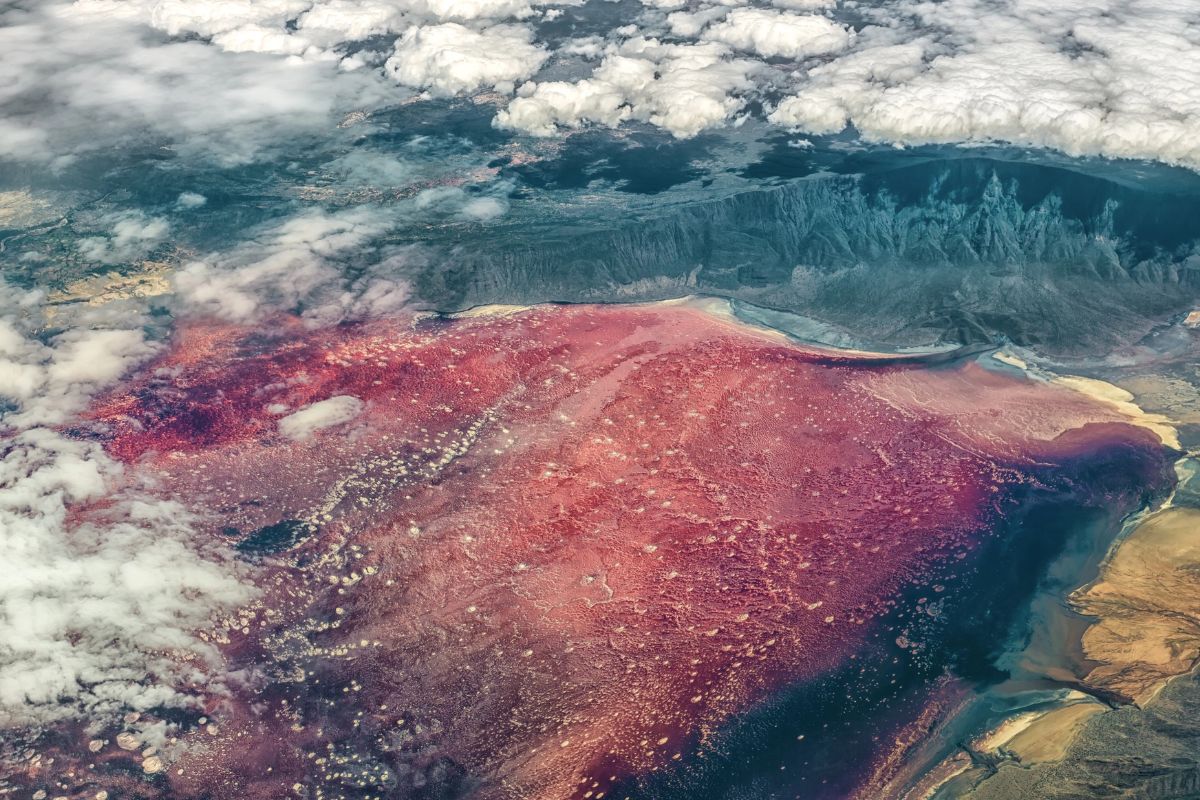Show table of content Hide table of content
In the heart of Tanzania lies a natural wonder that defies conventional expectations – Lake Natron. This striking crimson body of water captivates visitors with its surreal beauty while simultaneously harboring deadly properties. As one of Africa’s most unique natural phenomena, Lake Natron represents nature at its most extreme, creating an environment so hostile that it transforms deceased animals into calcified statues.
The blood-red waters of Tanzania’s most lethal lake
Lake Natron stretches across northern Tanzania, forming a shallow basin of caustic water that gleams with an otherworldly red hue under the African sun. This distinctive coloration stems from specialized microorganisms that thrive in its highly alkaline waters. Salt-loving haloarchaea and cyanobacteria produce vibrant red pigments as part of their survival mechanism in this extreme environment.
The lake’s chemistry creates a natural phenomenon unlike anything else on Earth. With pH levels reaching 10.5 – nearly as caustic as household ammonia – Lake Natron’s waters burn the skin and eyes of most animals that venture too close. This deadly cocktail forms through volcanic processes along the East African Rift System where tectonic movements are gradually splitting the continent. Minerals like sodium carbonate and calcium carbonate flow into the basin from surrounding hills and bubble up through hot springs beneath the lake bed.
During dry seasons, Lake Natron contracts dramatically, concentrating its already potent chemical makeup. Water temperatures can soar to 140°F (60°C), creating an environment that resembles a boiling cauldron. Despite measuring up to 9 miles (15 kilometers) across, the lake remains incredibly shallow – typically only 1.6 feet (0.5 meters) deep – allowing for rapid evaporation and dramatic seasonal changes.
How animals become stone sculptures in nature’s laboratory
The most haunting aspect of Lake Natron involves its ability to transform deceased wildlife into calcified statues. Animals unfortunate enough to perish along its shores undergo a natural preservation process that leaves them looking like stone sculptures frozen in time. This macabre transformation results from the lake’s high concentration of sodium carbonate, which essentially mummifies carcasses by replacing organic tissues with mineral deposits.
Photographer Nick Brandt brought international attention to this phenomenon in 2013 through his striking collection “Across the Ravaged Land.” His images captured perfectly preserved birds and bats positioned as if still alive despite having been calcified by the lake’s chemistry. These eerie portraits revealed doves, fish eagles, and other local wildlife transformed into ghostly monuments of themselves.
The petrification process happens remarkably quickly. When animals die in or near the lake, their bodies rapidly absorb the mineral-rich water. As evaporation occurs, calcium carbonate crystallizes within their tissues, gradually replacing organic material with stone-like formations. The result resembles ancient statues carved from alabaster – perfectly preserved in form but devoid of life.
This natural process mirrors artificial preservation techniques used by scientists to study population dynamics and ecological patterns. While humans have developed sophisticated methods for specimen preservation, Lake Natron performs this task automatically through its unique chemical properties.
Life thriving in death’s domain
Paradoxically, despite its lethal properties, Lake Natron serves as a critical habitat for certain specialized species. Most notably, it functions as the primary breeding ground for lesser flamingos (Phoeniconaias minor). These elegant birds have evolved specially adapted features that allow them to navigate the caustic waters safely. Their legs feature tough scales that resist chemical burns, while specialized beaks filter nutrients from the alkaline soup.
Between 1.5 and 2.5 million lesser flamingos – representing approximately 75% of their global population – rely on Lake Natron for reproduction. During dry seasons, the lake forms small islands where flamingos construct their nests safely isolated from most predators. Few hunters dare venture across the caustic waters, creating a perfect sanctuary for vulnerable chicks.
Interestingly, the same microorganisms that give Lake Natron its blood-red color also provide sustenance for these flamingos. The birds’ distinctive pink plumage develops from pigments absorbed through their diet of cyanobacteria harvested from the lake. This remarkable food chain demonstrates how even the most extreme environments can foster specialized ecological niches.
Science 50 years later, a quantum mystery has finally been solved.
Scientists studying extreme environments on Earth often use these unique ecosystems as models for understanding how life might develop on other planets. The adaptations seen in Lake Natron’s residents provide valuable insights into biological resilience under harsh conditions, somewhat similar to those observed in extraterrestrial environments like Mars.
Visiting this natural wonder safely
For adventurous travelers seeking unique destinations beyond conventional tourist hotspots, Lake Natron offers an unparalleled experience. However, visiting requires careful planning and respect for this dangerous natural wonder. Local guides familiar with safe viewing areas provide essential expertise for tourists wishing to witness the crimson waters and flamingo colonies.
The surrounding landscape presents a stark contrast to the deadly lake. Salt marshes and freshwater wetlands support diverse wildlife including greater flamingos, pelicans, ostriches, buffalo, and wildebeest. These adjacent ecosystems create buffer zones where visitors can safely observe the region’s natural beauty without risking exposure to the lake’s caustic waters.
Conservation efforts focus on preserving Lake Natron’s delicate ecological balance. The Tanzania Wildlife Management Authority maintains strict protocols for tourism to ensure human activity doesn’t disrupt flamingo breeding patterns or alter the lake’s unique chemistry. These protections help ensure future generations can continue to marvel at this extraordinary natural phenomenon that simultaneously harbors death and sustains specialized life.
Science These people were paid not to use Google, yet they couldn’t resist.
As one of Earth’s most extreme environments, Lake Natron reminds us that nature’s most inhospitable corners often reveal fascinating adaptations and unexpected beauty. Its blood-red waters and stone-like animal remains serve as a powerful testament to life’s resilience and the planet’s incredible diversity.


